|
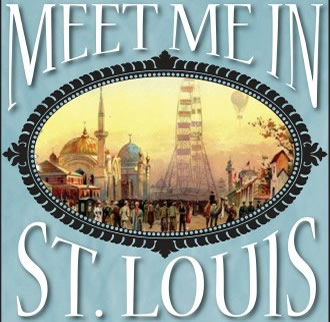 
auf der Weltausstellung 1904 in St. Louis / USA
The Louisiana Purchase Exposition - World Fair St. Louis 1904
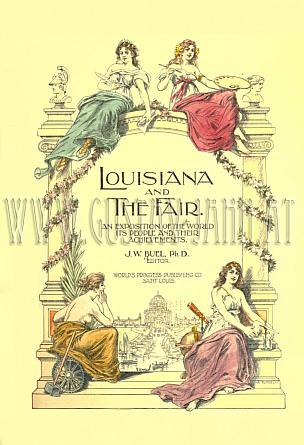 Die Louisiana Purchase Exposition (informell auch als "The Saint Louis World's Fair" bekannt) war eine Weltausstellung, die vom 30. April bis 1. Dezember 1904 in St. Louis im amerikanischen Bundesstaat Missouri stattfand. Die Ausstellung wurde – mit einem Jahr Verspätung – zur Feier des 100. Jubiläums des Louisiana Purchase von 1803, also des Verkaufs der französischen Kolonie Louisiana an die Vereinigten Staaten, organisiert. Die Louisiana Purchase Exposition (informell auch als "The Saint Louis World's Fair" bekannt) war eine Weltausstellung, die vom 30. April bis 1. Dezember 1904 in St. Louis im amerikanischen Bundesstaat Missouri stattfand. Die Ausstellung wurde – mit einem Jahr Verspätung – zur Feier des 100. Jubiläums des Louisiana Purchase von 1803, also des Verkaufs der französischen Kolonie Louisiana an die Vereinigten Staaten, organisiert.
Im Rahmen der Weltausstellung wurden auch die Olympischen Sommerspiele 1904 ausgetragen, die jedoch kaum Beachtung fanden. Insgesamt besuchten 19,7 Millionen Menschen die Ausstellung.
(OT: The Louisiana Purchase Exposition, informally known as the Saint Louis World's Fair, was an international exposition held in St. Louis, Missouri in 1904)
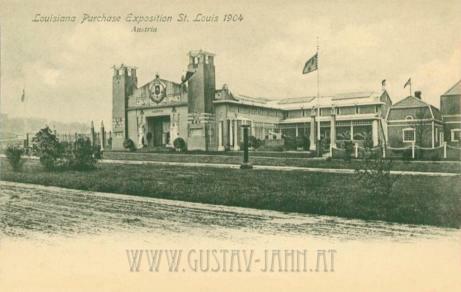 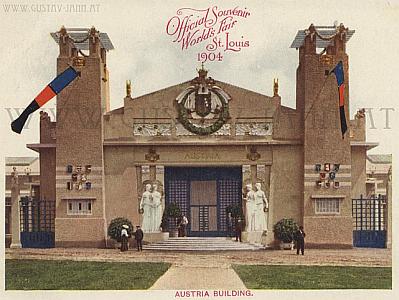 
Abbildungen: Louisiana Purchase Exposition, the Austrian Government Building
Neben Künstlern des Wiener Hagen Bundes (wie Cossmann Alfred (Vienna), Hegenbart, Fritz (Munich), Lefler, Heinrich, and Urban, Joseph (Vienna), Wesemann, Alfred (Vienna)) u.v.a. , waren auch Werke von Albin Egger Lienz, Ferdinant Andri, Alois Delug und Gustav Jahn in St. Louis vetreten, um für Österreich und seine Schönheiten zu werben.
Für die Weltausstellung gestaltete GUSTAV JAHN im Auftrag der K.K. Staatsbahngesellschaft, eine Reihe von (12) Alpenansichten.
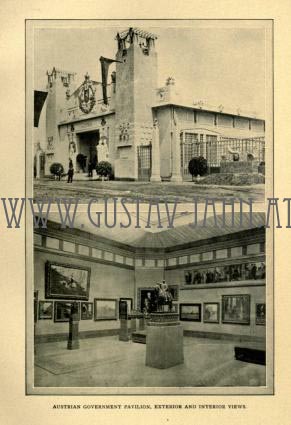 Gezeigt wurden diese im "Austrian Government Building", im Raum "illustrating austrian live and szenery" und er erhielt dafür das Diplom der bronzenen Medaille für Kunst. Gezeigt wurden diese im "Austrian Government Building", im Raum "illustrating austrian live and szenery" und er erhielt dafür das Diplom der bronzenen Medaille für Kunst.
Die großflächigen Friesen wurden nach dem Ende der Weltausstellung, im Dezember 1904 nach Wien transferriert und schmückten danach die Ankunftshalle des alten Wiener Westbahnhofes (Kaiserin Elisabeth-Bahnhof).
Der Verbleib dieser Bilder bzw. Friesen ist uns leider nicht bekannt. Auch ist es uns bis dato noch nicht gelungen, alte Innenaufnahmen oder Abbildungen des Wiener Westbahnhofes zu bekommen, worauf die Friesen Jahns zu sehen sind.
Ausstellungsverzeichnis Worlds Fair 1904 St.Louis
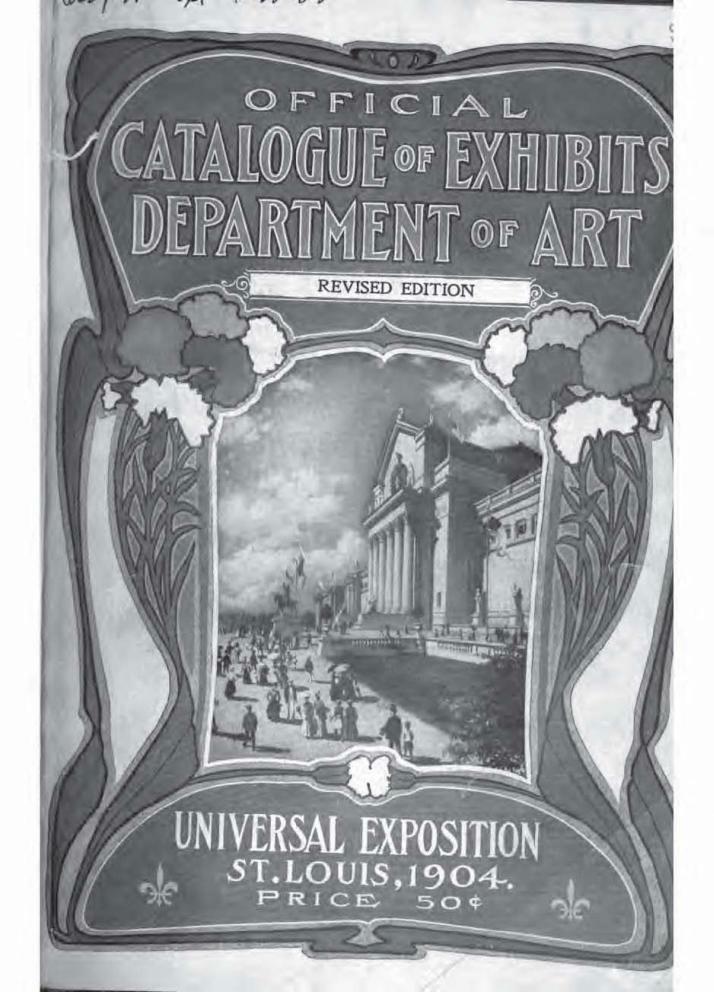  World Fair Saint Louis 1904 Official Catalogue of Art_LR.jpg) OFFICIAL CATALOGUE OF EXHIBITORS OFFICIAL CATALOGUE OF EXHIBITORS
Universal Exposition
ST. LOUIS, U.S.A. 1904 .
DIVISION OK EXHIBITS
FREDERICK J. V. SKIFF, Director
Department B, ART
JAHN Gustav, Vienna - Nr. 223 - Painted Friezes, installed in the room "illustrating austrian live and szenery"
HALSEY C. IVES, Chief
REVISED EDITION.
PUBLISHED FOR THE COMMITTEE ON PRESS AND PUBLICITY BY
THE OFFICIAL CATALOGUE COMPANY (INC.)
ST. LOUIS, 1904
JAHN Gustav, Vienna - Nr. 223 - Painted Friezes, installed in the room "illustrating austrian live and szenery"
Für die Darstellungen erhielt Jahn das Diplom der bronzenen Medaille für Kunst.
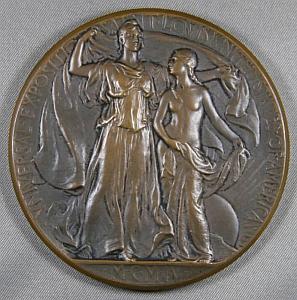 
Neben Künstlern des Wiener Hagen Bundes (wie Cossmann Alfred (Vienna), Hegenbart, Fritz (Munich), Lefler, Heinrich, and Urban, Joseph (Vienna), Wesemann, Alfred (Vienna)) u.v.a. , waren auch Werke von Albin Egger Lienz, Ferdinant Andri, Alois Delug und Gustav Jahn in St. Louis vetreten, um für Österreich und seine Schönheiten zu werben.
Weitere Künstler:
Adams, John Quincy, Vienna. Bara, Leopold, Vienna. Bernt, Rudolf, Vienna. Brunner, Ferdinand, Vienna. Czech, Emil, Vienna. Danilowatz, Joseph, Vienna. Darnaut, Hugo, Vienna. Delug, Alois, Vienna. Egger-Lienz, Albion, Vienna. Egner, Marie, Vienna. Fischer, Ludwig Hems, Vienna. Geller, Johann Nepomuk, Vienna. Hamza, Johann, Vienna. Hessl, Gustav H., Vienna. Jungwirth, Joseph, Kirchberg. Kaufmann, Adolf, Vienna. Koch, Ludwig, Vienna. Kruis, Ferdinand, Vienna. Larwin, Hans, Vienna. Lebiedzki, Eduard, Vienna. Lohwag, Ernestine, Vienna. Mielich, A. L., Vienna. Petrovits, Ladislaus Eugen, Vienna. Pfluegl, Alfred von, Vienna. Pippich, Karl, Vienna. Probst, Karl, Vienna. Ribarz, Rudolf, Vienna. Russ, Robert, Vienna.
Final Report of the Louisiana Purchase Exposition Commission
by
Louisiana Purchase Exposition Commission Part 6 out of 16 APPENDIX 3.
REPORTS OF FOREIGN COUNTRIES.
AUSTRIA.
Austrian commission - Mr. Adalbert R. Von Stibral, commissioner-general - Mr. Victor Pillwax, assistant commissioner; Mr.
Dominik Fetz, secretary; Mr. Emil S. Fischer, commercial secretary.
Austrian commercial commission - Count Johann Harrach, president; Mr.
Oskar Edler Von Hoefft, first vice-president; Mr. Franz Hiess, second vice-president; Mr. Charles M. Rosenthal, executive commissioner; Mr.
Johann Peterka, commercial director; Mr. Adolph Taussig, commercial representative and assistant commissioner.
One of the most interesting and, as far as the interior scheme of
decoration is concerned, the most artistic of the various foreign
buildings in the World's Fair grounds, was that of the Austrian Empire.
It was most prominently situated at the western end of Administration avenue, immediately opposite the Administration Building of the World's Fair. The garden at the west end of the pavilion, though small, attracted a great deal of attention on account of its artistic beauty. Morning-glory and other vines had been planted around the building, and before the close of the fair had covered the walls and added much to the beauty of the structure.
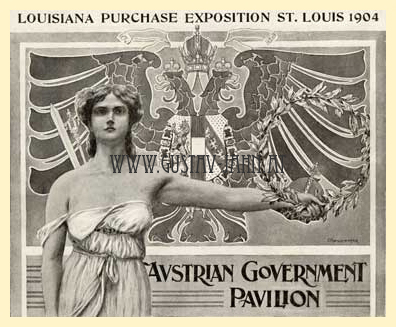 
LOUISIANA PURCHASE EXPOSITION (VOL. VI - Page 2124)
FOREIGN BUILDINGS
Austria's National Pavilion
In designing a national pavilion for Austria the architect, Ludwig Baumann, of Vienna, departed from classic style which
generally prevails at Expositions and adopted L/Art Nouveau, or new art, which would appear to be an appropriate
recognition of the spirit of progress which the Fair is intended to exemplify. With much boldness the architect
introduced a radical feature in designing the facade, which is made strikingly prominent by two large, square pylons on
the corners of a highly decorative entrance flanked by sculptured female figures. Above the square entablature is an
ornate frieze and above this, and partly covering it, is a wreath in basrelief within which are the Austrian Coat-of-
Arms.
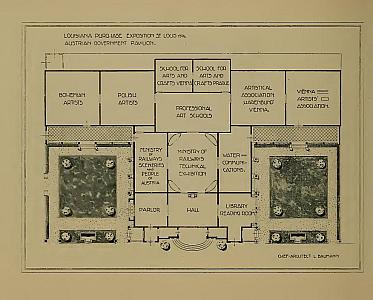 The pavilion is a T-shaped single story, with projecting facades fronting the avenue leading to the Exposition, but the
corner spaces are enclosed and utilized for garden effects, in which pillars and statuary are features no less prominent
than shrubbery, flowers and clambering vines. The pavilion is a T-shaped single story, with projecting facades fronting the avenue leading to the Exposition, but the
corner spaces are enclosed and utilized for garden effects, in which pillars and statuary are features no less prominent
than shrubbery, flowers and clambering vines.
The building contains thirteen beautifully decorated rooms, the first a reception hall of white maple, with wall
treatment in white and yellow. Opposite the wide doorway is a splendid bust figure, in marble, of Emperor Franz Joseph.
Opening off the reception hall, on the right, is a reading-room finished in maple, the floors and ceiling of which are
inlaid parquetry, book-case of walnut, rugs and hangings of green, windows of art glass, and a beautiful
onyx mantel over a comfortable fireplace. In this room is a marble plaquette by Weichl, with a relief figure of Empress
Elizabeth. On the left of the hall is a drawing-room, in which the woodwork is of old oak, and the walls are hung with yellow satin brocade, which produces a gorgeous effect. The other rooms of the building are devoted to art and industrial exhibits, the center section containing models of bridges of which the one that , represents the bridge-weir at Nussdorf, near Vienna, is most interesting, for it is said to be the largest railroad bridge arch in the world. In an adjoining room is an instructive railroad exhibit made by the Ministry of Railways, sections, in miniature, being shown to illustrate great engineering feats in tunneling, escarpment work, and bridging in mountainous regions of Austria.
Arts and crafts are well represented in the pavilion exhibits, in which design and decoration of the rooms are of a
distinctly artistic character. In these are shown paintings by Austrian artists, and especially productions by students
in the Imperial Professional Art Schools, of art glass, tapestries, plaques, bronzes, marbles, panels and paintings. The
Hagen Bund, a new society of artists, of Vienna, makes a display of paintings of the impressionist, or what they call
the paintillist style, which is just now obtaining some popular recognition in Europe. The Society of Artists of Vienna
also exhibits paintings of the
classical Romantique style, and Polish artists of Kracow contribute four large panels, by Joseph Mehoeffer, all being ofreligious subjects, admirably treated.
The Austrian building in all respects, exterior and interior, is a magnificent contribution to the Exposition and well worthy of the great nation it represents. The Commissioner-General is Adelbert R. Von Stibral, with Victor Pillwax as assistant, and Dominik Fetz secretary.
The Austrian Government Building was of impressionistic architecture from Architekt Ludwig Baumann K.K. Oberbaurat
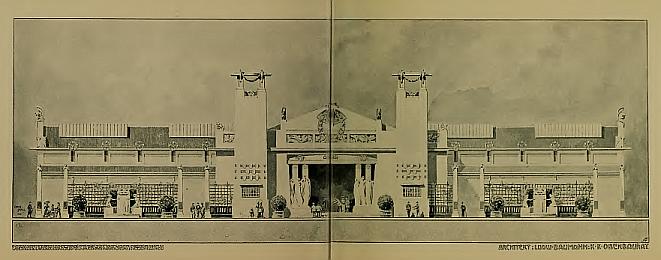
PAVILION AND DIVISION * * * OF ROOMS, * * *
The Austrian Government Pavilion is 60 meters long and 35 meters wide and built in T form* From the transepts a middle aisle, 24 meters broad, extends to the building line* On either side of the aisle exits lead to the loggias and to the lawns* The pavilion is built of wood, and all the rooms have skylights. The style of architecture and decorations is modern with a classical toning. The exterior of the building is faced with a grayish yellow coloured gypsum shaded with gold, dark blue and light green. Two groups of figures — above life size — adorn the main porch of the central building. The Imperial coat of arms with a crown, surrounded by a large wreath, is raised above the centre of the pavilion, and to the right and left two sphinxes crown the gables.
The central building (garden-front) is finished off with two enormous square pylons with festoons and masks and decorated with all the coats of arms of the Austrian crown lands. Four stela bearing gilded busts are symmetrically placed along the front of the flower-beds in which monumental fountains have been erected. As can be seen from the annexed ground plan the interior of the pavilion is divided into fifteen rooms. To the left and right of the entrance hall which is adorned with a marble bust of the Emperor are the official apartments one of which is meant as a library and reading room, and the other as a reception room. Beyond the entrance hall is the Technical exhibition of the Ministry of Rail'
ways, which likewise occupies the room on the left hand side for its exhibition "Sceneries and People of Austria".
The hall to the right is devoted to the department of the Ministry of Commerce for the Building of Waterways. At the back part of the middle aisle a large hall is devoted to the exhibits of the professional Art schools andtwo smaller ones show interiors executed by the Schools for Arts and Craftsin Vienna and Prague. The fine art exhibits of the Vienna Artists' Associationand of the Association called "Hagenbund" are on the right of the transepts;the pictures of the Bohemian and Polish artists on the opposite side.
Before briefly describing the characterstics of each section, according to the order of the rooms, a list must be given of the artists and artisans who have taken part in building and decorating the Austrian Government Pavilion. The plans of the whole building, the entrance hall, the two halls of the Ministry of Railways, and the hall containing the exhibition of Waterways have been designed by the chief architect Oberbaurat Ludwig Baumann, Joseph Meissner substituting him in the superintendence of the works.
(Contractor: J. Lecoeur).
The library has been designed by Leopold Bauer, architect, and the architect Joseph Plecnik has designed the reception room. The plastic on the outside of the building has been delivered by the sculptor Othmar Schimkowitz. The figurate frieze in the library is the work of the painter Josef En gelhardt. The painter Ferdinand An dri has executed the frescos on the facade, and Heinrich Tomec those in the department for water-ways. The Emperor's bust, which is made of Laaser marble, and which has been executed in the workshop of the Tyrol Marble and Porphyry Company (Fritz Zeller) Laas (Tyrol), is a copy of Prof. Strasser's model. The relief "Empress Elisabeth'' (Allegory) in the reception room is by the late Rudolf Weigl, sculptor.
Sandor J dray has been entrusted with the Interior decorations and fittings. The carpets have been delivered by J. Ginzkey, Maffersdorf, and the ornamental locksmith^work by Alexander Nehr. The mosaic and artistic glass work have been delivered by MaxFreiherr v. Spaun and Johann Kappner, the fancy needlework by Carl Giani, the inlaid work (Intarsia) has been carried out by Michael Kehl, Josef Duchoslav, Franz Makienec. and the bronze works by Johann Hastach, Carl Kratky, J. Schubert and A. T. Lange.
TECHNICAL EXHIBITION OF THE * * MINISTRY OF RAILWAYS. * *
Austria is the home of European Alpine railways; the oldest, the Semmering railway, constructed 1848—1854, lies on the South Railway main line from Vienna to Trieste and is the first mountain railway conducted exclusively on the adhesive principle. Then followed the Brenner railway (1864—1867), the shortest railway communication between Central Germany via Tyrol to Italy (Verona), and the Arlberg railway (1880—1884) which opened up the route via Tyrol and Vorarlberg to the west (Switzerland and France).
An extensive system of alpine railways in course of construction (the Tauern, Karawanken and Wocheiner) will establish a new connection between the Interior of Austria and the port of Trieste, Four great panoramas in the Exhibition showing the above-mentioned alpine railways bear witness to Austria's prominence in this special field of railway technic. There are also plans of these lines, photographic views of buildings and of the tracks of the first three mentioned lines which are in full working order. The lines in course of construction are further illustrated by models of tunnels, scaffoldings, foundations of arched bridges ; and also an electric boring machine. A view of an arched bridge (with a span of 80 m) over the Isonzo (Littoral lands of Austria) with statical calculations and charts of the largest vaulted bridges ever built, and photographic views of the working in the Karawanken and Wocheiner Tunnels. Among the other exhibits in this department may be mentioned a model of the ground-work of the Austrian State
Railways for express trains, photos of the Imperial Court train and of the newest locomotives and passenger-carriages of the Austrian State Railways, as well as plans for iron bridges, ground-work, locomotives and passenger carriages of the State Railways. The work published for the Emperor's Jubilee "History of the railways of the Austro-Hungarian Monarchy" together with a number of other publications on the statistics, pedagogy and technics of railways are exhibited. Finally there is a chart of the railways of the Austro-Hungarian Monarchy on a scale 1 : 1,000,000.
SCENERIES AND PEOPLE * * * OF AUSTRIA, * * *
For a long time the Austrian Ministry of Railways has set itself the task of drawing the attention of the travelling public to the beauties of the scenery and ethnographical charms in which Austria abounds and thus inducing them to visit the country. To gain this end the Ministry has issued various publications, has opened inquiry offices and arranged exhibitions.
The exhibition "Sceneries and People of Austria" in the government pavilion at St. Louis has been arranged with the co-operation of several artists for the same object. The exhibit principally consists of a collection of views of the most beautiful parts of Austria, especially the Austrian Alps, and pictures of Austrian national life. Photographs taken by the best photographers as well as a number of artistic amateur photos representing the most important travelling districts in Austria, (99 in all) have been enlarged and reproduced as pigment prints or linographs. Two series of 10 photographic prints are also exhibited ; the one consisting of Austrian castles and strongholds, and the other of various favourite alpine resorts. Further a selection of alpine and travelling works in luxurious editions are shown.
The whole exhibition is finished off with a collection of 14 pictures of costumes and sport, arranged like a frieze, and illustrating special Austrian national scenes around the top of the wall.
Finally four bronze statuettes viz: "Chamois-hunter", "Alpine-tourist", "Ski-sportsman", "Alpine dairy-woman" have been placed in the room as decorations.
WATERWAYS.
The exhibition of models, plans and photographs of the existing and projected canals for deep draft ships arranged by the Department of the Ministry of Commerce for the Building of Waterways offers a general view of the whole network of the Austrian Waterways comprising those of the Danube, Moldau and Elbe Rivers, together with the system of canals. The largest Austrian river the Danube, which flows through the Country from West to East having a course of 348 km, is well adapted for tug traffic; the iron tug boats generally used having a drawing capacity of 650 t. The beautiful landscape of the river sides is shown by means of views of the Danube, contained in an album, whilst the plans, photographs and models exhibited by the ''Danube Regulation Commission" show the river courses, the harbours in Lower Austria and Vienna, as well as the constructions for regulating the water level in the Vienna-Danube Canal. The second great waterway is the Moldau and the Elbe running from South to North. On that part of the Elbe flowing between Aussig and the frontiers (a length of 38 km) the greatest amount of traffic is done and amounted in 1901 to about 4,000,000 t or 150,000,000 TKM.
In order to secure unhindered communication for tugs of 900 t drawing capacity on the Elbe between Aussig and Prague during the period when the Elbe is open, it was decided to construct canals along this stretch of river (Aussig—Prague 122 km long) with a minimal depth of 2*1 m thus providing a navigable route for large ships right into the heart of Bohemia. The work of construction carried out by the "Commission for Building Canals on the Moldau and Elbe Rivers in Bohemia" was commenced in 1897, and the models, plans and pictures exhibited by this Corporation show various stages of construction and the appearance of the works finished, whilst a map of Prague hanging on the wall shows the harbour and canal construction works, some finished and others projected in the precincts of the town.
The drawings and photos exhibited in the corner of the hall by the "Aussig-Teplitz Railway Co/' illustrate the position and traffic of the harbour of Aussig which is the most important inland harbour of Austria.
The network of navigable canals . for joining rivers together was provided for by Act of Parliament in 1901 and the "Administration for the Building of Waterways" so far furthered the preparation of the plans and designs for the construction of the different canals, that the work on some parts can be commenced this year. The charts in addition to giving a view of the position of the canals and rivers, with canals projected, show also longitudinal sections of the Danube-Oder Canal, which is the work to be taken in hand next, as well as some specimens of difficult engineering construction.
EXHIBITION OF THE IMPERIAL ROYAL * * PROFESSIONAL ART SCHOOLS. * *
The exhibition of the state professional Art schools, arranged by the Imperial Royal Ministry of public Instruction, Vienna, gives an idea of the work done by these institutions. These schools send out skilled workmen after giving them artistic and practical training in all branches of decorative art, fecundating practical work with artistic ideas and in this manner raising and furthering the standard of arts and crafts of the country. The exhibition is arranged in three divisions, the first two containing the exhibits of the schools for Arts and Crafts in Vienna and Prague (the largest of their kind in Austria), and the third the work of the other professional Art schools.
The decoration of the two interiors of the Schools for Arts and Crafts Vienna (Director Felizian Freiherr v. My r bach) and Prague (Director Georg Stibral), as well as all the objects exhibited in these divisions have been designed at the above institutions, and (as far as the schools possess workshops) executed by the pupils. A part of these objects has been entrusted to skilled craftsmen for execution. The organization of the "collective exhibition" of the other professional Art Schools has been entrusted to the Inspector of these schools, and Hofrat Arthur v. Sea la, Director of the Austrian Museum, Vienna.
The designs for the interior decorations have been prepared by the head of the Educational Supply Department at the above mentioned museum, and the details worked out by the department itself. The interior and the exhibits themselves have been executed in the workshops of 46 different professional Art schools with the co-operation of the pupils. The illustrated catalogue of the exhibits of the Imperial Royal professional Art schools contains full details of this exhibition and gives a general view of the organization of Technical Education in Austria.
FINE ARTS.
As may be easily understood it is a rather difficult task in a large country, even at home, to offer a comprehensive insight into the conditions of fine arts. Many works of art have been created for certain surroundings from which they cannot be removed without suffering in their artistic effect. Other works have passed into private hands and are scattered far and wide and for different reasons are not to be had for sending on a long journey. At the outset, therefore, the idea had to be given up of offering at the St. Louis Exhibition, to any extent, a complete picture of the Austrian Art of the present day, the more so as the diverse nationalities of Austria make the art of this country one of the most manifold and varied of the civilised world.
It has nevertheless been possible to get a considerable number of works together which give, at least, a fairly good idea of the abundance of Austrian art. Two groups of rooms have been placed at the disposal of Austrian fine arts ; one hall with annexe in the General Art Building and four halls in the Austrian Government Pavilion.
A part of the exhibits of the Vienna Artists' Association is to be found in the general Art Building, and the restr as well as those of the Artists' Association "Hagenbund" and the Bohemian and Polish Artists, are placed in the Austrian Government Pavilion.
The Vienna Artists' Association was founded in 1861, and has at present 356 "ordinary members", 104 "extraordinary members", and numerous supporting and corresponding members. The association is exhibiting 154 paintings, engravings, pen and ink sketches, and sculptures. The Association "Hagenbund", which was founded in 1901 devoting itself specially to cultivating Austrian Fine Art, has at present 49 members and is exhibiting 42 paintings, etchings, sculptures and a few publications.The exhibitions of the Bohemian artists (41 pictures) and of the Polish artists (50 paintings, plastics and graphics) have not been arranged according to any division of different groups of artists.In some rooms also art-handicraft work of the respective groups of artists can be seen.
Catalogues of the Austrian Works of Art can be obtained gratis in the Austrian Government Pavilion.
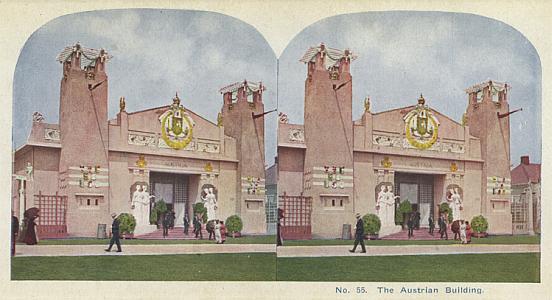
(Abb: Stereoview: Nr. 55 The Austrian Building)
LOUISIANA PURCHASE EXPOSITION
DIVISION CXI.
Austrian Art Exhibition. (Page 2621- 2632)
The condition of art in Austria is somewhat anomalous, due to several causes, but principally to the secession movement of about 1897, which has resulted in a breaking up of old lines and a scattering into schools as various in styles as there are coteries to maintain them, although Austrian artists contend that there are in fact only two schools, "the old" and "the new." Vienna for a long while for at least a century enjoyed the distinction of being an art centre, in which there was both accord and cooperation, notwithstanding the introduction of electicism in 1858, which produced a variety of styles; but instead of dividing into parties, as has been the case in all other countries, Austrian artists while preserving their individuality worked in consonance under the mutual aim to elevate their profession purely for art's sake. This animating purpose was continued until impressionism gained entrance to this house of harmonious fellowship when, behold, dissension directly resulted and there was an alignment of artists into factions, as in Germany, which for fierceness may be compared to the rival houses of Montague and Capulet. There were leaders, of course, but envy has prevented acknowledgment, and to avoid offending the dignity of the various influences names are withheld.
At the great international art exhibition at St. Louis Austrian artists were well represented, but it was not in connecting galleries. The Exposition director, in a magnanimous and conciliatory spirit, courteously explains that, "It was found possible only to install a portion of Austria's fine and representative exhibit in the galleries which had been assigned to her in the Art Palace, and it was impossible to increase the space allotted ; so a great part of the collection was exhibited in the National Pavilion, where, in several characteristically decorated galleries, it is shown to good advantage." All of which is quite true and fully explanatory, though Austrians themselves told me it was not because of dilatoriness that their art exhibit arrived after the space originally assigned had been occupied.
>> ... zum Weiterlesen bzw. Anzeigen des ganzen Originaltextes bitte hier klicken (=Text aufklappen)
All this, however, is aside from the interest that attached to the display of pictures made by Austrian artists. Nor is it such an unusual thing, either, for rivalry to be carried to extremes; the same thing may be said of the German exhibition, the Impressionist school, which being non grata to the Emperor, and excluded, set up an exhibition gallery of their own in a building on Chouteau Avenue, which they hired for the purpose. And, it may be added, Russia's and Hungary's exhibits were similarly divided, though from a different cause.
It is gratifying to American pride to know that Austria was represented by her greatest painters, and that in this representation were many of the most distinguished artists of the age. For, let it be understood, that factional spirit has not repressed ambition, or curtailed talent; upon the contrary, it is possible that the rivalry of which I have spoken may have caused a more rapid development of art in Austria, as competition usually operates to bring out the best.
In galleries 1 and 68 of the East Pavilion of Art Palace 52 Austrian artists exhibited 120 paintings. In the Bohemian artists' section of the Austrian Government Pavilion there were 17 exhibitors and 42 examples. The Kuenstler- Bund "Hagen" association, of Vienna, in the Pavilion, had 4 exhibitors and 12 examples, chiefly etchings. Besides these there was a room in the Pavilion in which friezes ,and dioramic paintings were shown, and a second Bohemian artists' section in the Pavilion, which was devoted to etchings and lithographs. The total number of pictures, of all kinds, displayed was 264. Considering the comparatively few paintings and drawings exhibited it is somewhat surprising to know that there were awarded to Austrian artists 8 gold medals, 20 silver medals, and 19 bronze medals. Winner of the Grand Prize was Walter Hampel, a member of the Kuenstler-Bund "Hagen" association, who showed a curious painting entitled "The Dwarf and the Woman." What does it signify? Well, it is better to allow others to draw their inference than to hazard an interpretation based upon supposititious premises. The composition consisted of a nude woman who, being just emerged from a near-by pool, sits upon a mass of white drapery while she is drying one of her feet and looking coquettishly at a very funny, though solemn-faced, dwarf who is crouched upon the ground a few feet in front of her. The woman, youthful, debonair, romantic, affects no surprise, neither is there a maiden's wish expressed in her features. She is simply roguish, a bit curious, perhaps, but not at all serious, and seems to have a mind to abash the little old man who has discovered her at the bath. The dwarf belongs to the legends of long ago, a mannikin in crimson who supports a pack upon his back which may contain wishes, good and bad. He appears to be content to feast his impish eyes upon so much nude loveliness, and is in no haste to explain his intrusion or to excite the object of his admiration into making a request. It is evidently romance land into which the two have wandered, for the woods about are bathed in an opalescent atmosphere, the earth is bestrewn with flowers, and the undraped figure is lusciously tinted with warm, rich hues of youth and health. What does it mean ? Frankly, I have no idea. Walter Hampel was born in Vienna, 1867, and all the inspiration of his art may be said to have been obtained in that city, where he studied in the Imperial Academy under Makart until he went to Italy to complete his education. Afterwards he traveled extensively in France and Germany and then returned to Vienna, 1895, to open a studio. Juljan Falat, of Cracow, a member of the Polish Artists' Association, exhibited four pictures, viz., "The Owl," "Maid from the Neighborhood of Cracow," "Portrait, and View of Cracow," and "A Winter Scene." The last named, though simple in theme, was much the best of the four. The subject represented a boundless landscape, covered with snow, lying under a blue sky. In the foreground is a small stream, the dark blue water of which affords a sharp contrast to purple tints in the sky and the rich glow of sunlight that is diffused in the atmosphere and spreads a gleam upon the snow. The picture is realistic of a winter afternoon in a woodless country, cold, but fresh, invigorating, and full of vitality. The real gem of the Austrian collection, if one may venture an opinion upon so delicate a matter, was "The Witches' Sabbath," painted by Alois H. Schram, of Vienna. Here is a picture that personates, so truthful is it in characterization, the fancies alike of childhood and of mature years. But the composition embraces much more than the terrifying spectacle that was conjured by imagination builded upon witch stories told us in our youth. Who has not heard of the annual gatherings, in the Black Forest, of the emissaries of Beelzebub, so graphically described by Goethe in Faust? Schram no doubt borrowed his idea from this legend, but he has given to the old tale a new complexion, a real lesson, a true interpretation. He paints, though in the background, the weird, demoniac sisterhood, the loup-garous and shedims, a screeching, frenzied, horrific procession of hellish savagery; but in the foreground he places a flying troop of seductive spirits, fallen angels that retain the outer sem-r blance of ravishing beauty, who by voluptuous saturnalia entice their admirers to destruction. It is a powerful conception, an awful representation, but it teaches a lesson more impressive than words are capable of conveying, for to look upon it is to know and feel the motive of the artist. For this wonderful portraiture of allective sin and its consequences Schram was awarded a gold medal, which scarcely measured the fullness of his deserving. Contradistinguished from "The Witches' Sabbath" was a master composition submitted by Rudolph Konopa, entitled "Adoration," an idyl, which shows a madonna-like mother seated upon a flowery bank holding a babe, and around the heads of both are coronas of holiness. Before the two are four children, in attitudes of devotion, one of whom is offering marguerites which she has gathered from adjacent fields. The expression of the mother is beatific and that of the children is reverential ; while the entire scene is one that combines all the accessories of worshipful devotion. Other paintings exhibited by Konopa were, "In the Meadow," lent by the Imperial Board of Education, and "The Cowherd." The work of Viennese artists generally exhibits a pietistic tendency, and therein it is a reflection of early Italian painters whose influence still dominates, in a great degree at least, both Austrian and Hungarian painters. Among those who particularly emphasize this observation is Charles Wilda (1854), who has been honored with medals at art exhibitions held in his native city and also at the Paris Exposition of 1900. He was represented at St. Louis by two paintings, "Flight into Egypt" and "Wise Men from the East." His treatment of the latter is so distinctly original that a title to the picture is necessary to give the observer an idea of what is intended by the artist. The subject, as we best know it, particularly by the drawings of Beda and Dore, represent the Magi either traveling, or bestowing their gifts upon the "Young Child." Mr. Wilda's picture is a night scene, illuminated by bright moonlight which reveals several figures, three of whom, advanced, are seen kneeling before an opening in a wall where a lamp is burning, the light from which falls strongly upon their heads. Behind the Magiare several villagers who have been attracted by the oriental appearance of the strangers and are curious to ascertain the object .of their visit. Mr. Wilda besides being original has succeeded in producing a strong and very effective picture, for his posing is excellent and the diffusion of moonlight and lamplight, a very difficult thing to harmonize, is remarkably well done. In the Polish Artists' Association Gallery of the Austrian Pavilion appeared a portrait character entitled "A Singer," that was the work of Josef Edler Von Mehoffer, of Cracow. Though Von Mehoffer belongs to the Impressionist school of Vienna artists he has departed from that style in painting "A Singer." Indeed, the work is a finished example of portraiture in color, technique, and detail. The figure is that of a lady who, in a black skirt and a diaphanousfischu, stands with the right foot advanced, about to render a number before a parlor audience. Behind her are rich brocaded curtains slightly parted to show the faces of three men seated at a table in an adjoining room. The pose of the figure, as well also the expression, indicates diffidence, which one might be expected to show when appearing at a rehearsal or before a private audience. From this viewpoint the artist has painted an amateur singer and the situation, with very realistic effect. Von Mehoffer is one of the most famous artists of Austria. He studied at the Royal Academy of Cracow as a pupil of Matejko, and later went to Paris and took a course at the School of Fine Arts. He received gold medal honors at Lenberg and Cracow, and in 1900 was honored in like manner at the Paris Exposition. Besides being a noted painter, Von Mehoffer has achieved fame as a designer and decorator, especially of cathedral windows, in addition to which he is an accomplished writer and critic. His picture was awarded a gold medal at St. Louis.
Other distinguished Austrian and Hungarian artists represented at the Exposition were: F. E. Laszlo, J. de Thorma, H. Poll, Eduard Lebiedzki, Alois Delug, Adolph Kauffman, Max Svabinsky, Jan Priesler, Edler Von H. Kempf, Gustav H. Hessl, Victor Stauffer, and Gustav Jahn (friezes).
It was a circumstance very deeply regretted that not a single example of Michael Munkacsy's (born October, 1846), work, except one study, was exhibited, either in the Hungarian section or in the United States loan collection. This is particularly disappointing, as one of the prime purposes of the Art Exhibition was to present a showing of art and artists of the past ten years, and Munkacsy did not die until May, 1900. As the greatest, not only of Hungarian artists but as a representative of the world masters, it is interesting to know that the real name of Munkacsy was Lieb, and that he was originally a carpenter. That he ever became an artist is due to the influence of a strolling portrait-painter who, by chance observing some of his building plans, discovered his latent talent and persuaded him to take lessons in art. His progress was so amazing that a year later he was painting portraits for a living, to which profession he soon added genre productions, one of his first, "A Country Idyl," was purchased by the Art Union of Pesth. Without following his wonderful career, during which he produced several score of now famous paintings, it may be said that he reached the climax of his power in 1882, when he gave to the world his "Christ Before Pilate," which is said to be the greatest picture of a century, and which after being exhibited in all cities of the country was sold to Mr. John Wanamaker, of Philadelphia, for $120.000,-- After producing this almost incomparable, and intensely dramatic as well as tragic composition, Munkacsy painted two other imperishable creations, viz., "Christ on Calvary" and "The Last Moments of Mozart." The latter was sold to the late General Russell A. Alger, of Detroit, for $50,000,--. It is very sad to conclude this brief notice of one of the world's greatest masters with a statement of the fact that during the last three years he suffered from mental aberration and his life closed in gloom in a sanitarium.
The Final Report of the Louisiana Purchase Exposition Commission by Louisiana Purchase Exposition Commission AUSTRIA.
>> ... zum Weiterlesen bzw. Anzeigen des ganzen Originaltextes bitte hier klicken (=Text aufklappen)
_Austrian commission._--Mr. Adalbert R. Von Stibral,
commissioner-general; Mr. Victor Pillwax, assistant commissioner; Mr.
Dominik Fetz, secretary; Mr. Emil S. Fischer, commercial secretary.
_Austrian commercial commission._--Count Johann Harrach, president; Mr.
Oskar Edler Von Hoefft, first vice-president; Mr. Franz Hiess, second
vice-president; Mr. Charles M. Rosenthal, executive commissioner; Mr.
Johann Peterka, commercial director; Mr. Adolph Taussig, commercial
representative and assistant commissioner.
One of the most interesting and, as far as the interior scheme of
decoration is concerned, the most artistic of the various foreign
buildings in the World's Fair grounds, was that of the Austrian Empire.
It was most prominently situated at the western end of Administration
avenue, immediately opposite the Administration Building of the World's
Fair. The garden at the west end of the pavilion, though small,
attracted a great deal of attention on account of its artistic beauty.
Morning-glory and other vines had been planted around the building, and
before the close of the fair had covered the walls and added much to the
beauty of the structure.
The Austrian Government Building was of impressionistic architecture. It
was 60 meters long, 35 meters wide, and built in the form of a T. From
the transepts a middle aisle, 24 meters broad, extended to the building
line. On either side of the aisle exits led to the loggias and to the
lawns. The pavilion was built of wood and all the rooms had skylights.
The style of architecture and decoration was modern, with a classical
toning. The exterior of the building was faced with a grayish,
yellow-colored gypsum, shaded with gold, dark blue, and light green. Two
groups of figures, above life size, adorned the main porch of the
central building. The imperial coat of arms, with a crown surrounded by
a large wreath, was raised above the center of the pavilion, and to the
right and left two sphinxes crowned the gables. The center building
(garden front) was finished with two enormous square pylons, with
festoons and masks and decorated with all the coats of arms of the
Austrian crown lands. Four stela-bearing gilded busts were symmetrically
placed along the front of the flower beds, in which monumental fountains
had been erected. The interior of the building was divided into fifteen
rooms. To the left and right of the entrance hall, which was adorned
with a marble bust of the Emperor, were the official apartments, one of
which was meant as a library and reading room and the other as a
reception room. Beyond the entrance hall was the technical exhibition of
the ministry of railways, which likewise occupied the room on the
left-hand side for an exhibition, "Sceneries and People of Austria." The
hall to the right was devoted to the department of the ministry of
commerce for the building of waterways. At the back part of the middle
aisle a large hall was devoted to the exhibits of the professional art
schools, and two smaller ones showed interiors executed by the schools
for arts and crafts in Vienna and Prague. The fine-arts exhibits of the
Vienna Artists' Association and of the association called "Hagenbund"
were on the right of the transepts; pictures by Bohemian and Polish
artists on the opposite side.
The artists and artisans who took part in building and decorating the
Austrian Government pavilion were as follows: The plans of the whole
building, the entrance hall, the two halls of the ministry of railways,
and the hall containing the exhibition of waterways were designed by the
chief architect, Oberbaurat Ludwig Bauman, Josef Meissner substituting
him in the superintendence of the works; contractor J. Lecoeur.
The library was designed by Leopold Bauer, architect, and the architect
Joseph Pleonik designed the reception room.
The plastic on the outside of the building was delivered by the sculptor
Othmar Schimkowitz. The figurate frieze in the library was the work of
the painter Josef Engerhart. The painter Ferdinand Andri executed the
frescoes on the facade and Meinrich Tomec those in the department for
waterways. The Emperor's bust, which was made of Lassar marble and which
had been executed in the workshop of the Tyrol Marble and Porphyry
Company (Fritz Zeller), Laas (Tyrol), was a copy of Professor Strasser's
model.
The relief "Empress Elizabeth" (allegory) in the reception room was by
the late Rudolf Weigl, sculptor.
Sandor Jaray had been intrusted with the interior decorations and
fittings. The carpets were delivered by J. Ginskey, Maffendorf, and the
ornamental locksmith work by Alexander Nehr.
The mosaic and artistic work was done by Max Freiherr von Spann and
Johann Kappner; the fancy needlework by Carl Giani; the inlaid work
(intarsia) by Michael Kehl, Josef Duchoslav, and Franz Makienec, and the
bronze works by Johann Hastach, Carl Kratky, J. Schubert, and A.T.
Lange. On account of the beauty of its furnishings and the harmonious
color schemes of the interior the pavilion was especially attractive to
women visitors to the fair.
Austria is the home of the European alpine railways. The oldest, the
Semmering Railway, constructed in 1848-1854, lies on the South Railway
main line from Vienna to Trieste and is the first mountain railway
conducted exclusively on the adhesive principle. Then followed the
Brenner Railway (1864-1867), the shortest railway communication between
central Germany via Tyrol to Italy (Verona), and the Arlberg Railway
(1880-1884), which opened up the route via Tyrol and Vorarlberg to the
west (Switzerland and France). Four great panoramas in the exhibition
showing the above-mentioned alpine railways were witness to Austria's
prominence in this special field of railway technique. One room in the
pavilion was devoted to the models of alpine railways. There were also
plans of the lines, photographic views of buildings and of the tracks of
the first three mentioned lines, which are in full working order. The
lines in course of construction were further illustrated by models of
tunnels, scaffoldings, foundations of arched bridge (with span of 80
meters) over the Isonzo (littoral lands of Austria), with statistical
calculations and charts of the largest vaulted bridges ever built, and
photographic views of the working in the Karawanken and Wocheiner
tunnels. Among the other exhibits in this department may be mentioned a
model of the groundwork of the Austrian State railways for express
trains, photos of the imperial court train and of the newest locomotives
and passenger carriages of the Austrian State railways, as well as plans
for iron bridges, groundwork, locomotives, and passenger carriages of
the State railways. The work published for the Emperor's jubilee,
"History of the Railways of the Austro-Hungarian Monarchy," together
with a number of other publications on the statistics, pedagogy, and
technique of railways, were exhibited. Finally, there was a chart of the
railways of the Austro-Hungarian monarchy on a scale of 1:1000000.
For a long time the Austrian ministry of railways set itself the task of
drawing the attention of the traveling public to the beauties of the
scenery and the ethnographical charms in which Austria abounds, and thus
inducing them to visit the country. To gain this end the ministry issued
various publications, opened inquiry offices, and arranged exhibitions.
The exhibition "Sceneries and People of Austria" in the Government
pavilion was arranged, with the cooperation of several artists, for the
same object. The exhibit principally consisted of a collection of views
of the most beautiful parts of Austria, especially the Austrian Alps,
and pictures of Austrian national life. Photographs taken by the best
photographers, as well as a number of artistic amateur photos,
representing important traveling districts in Austria (99 in all), were
enlarged and reproduced as pigment prints or linographs. Two series of
photographic prints were exhibited also, one consisting of Austrian
castles and strongholds and the other of various favorite alpine
resorts. Further, a selection of alpine and traveling works in luxurious
editions were shown.
The whole exhibition was finished off with a collection of 14 pictures
of costumes and sport, arranged like a frieze and illustrating special
Austrian national scenes. Four bronze statuettes, viz, "Chamois-hunter,"
"Alpine tourist," "Ski sportsman," "Alpine dairy woman," had been placed
in the room as decorations.
The exhibition of models, plans, and photographs of the existing and
projected canal for deep-draft ships, arranged by the department of the
ministry of commerce for the building of waterways, offered a general
view of the whole network of the Austrian waterways, comprising those of
the Danube, Moldau, and Elbe rivers, together with the system of canals.
The beautiful landscape of the river sides was shown by means of views
of the Danube, contained in an album, while the plans, photographs, and
models exhibited by the Danube Regulation Commission showed the river
courses, the harbor in lower Austria and Vienna, as well as the
construction for regulating the water level in the Vienna-Danube Canal.
A map of Prague showed the harbor and canal construction works, some
finished and others projected, in the precincts of the town. The
drawings and photos exhibited in a corner of the hall by the
Aussig-Teplitz Railway Company illustrated the position and traffic of
the harbor of Aussig, the most important inland harbor of Austria. The
charts, in addition to giving a view of the position of the canals and
rivers, with canals projected, showed also longitudinal sections of the
Danube-Oder Canal.
The exhibitions of the State professional art schools, arranged by the
imperial royal ministry of public instruction, Vienna, gave an idea of
the work done by these institutions. The exhibition was arranged in
three divisions, the first two containing the exhibits of the schools
for arts and crafts in Vienna and Prague (the largest of their kind in
Austria) and the third the work of the other professional art schools.
The decoration of the two interiors of the schools for arts and crafts,
Vienna (Director Felizian Freiherr von Myrbach) and Prague (Director
Georg Stibral), as well as all the objects exhibited in these divisions,
were designed at the above institutions and executed by the pupils. The
organization of the "collective exhibition" of the other professional
art schools was intrusted to the inspector of these schools and Hofrat
Arthur von Scala, director of the Austrian Museum, Vienna. The interior
and the exhibits themselves were executed in the workshops of 46
different professional art schools, with the cooperation of the pupils.
The amount of money appropriated by the Austrian Government for the
participation of the Austrian Empire at the exposition was 1,100,000
crowns (about $220,000). The appropriation, however, was almost
exclusively made for the display of Austria in connection with the
Austrian Government Pavilion. The appropriated amount had to cover the
expense for the erection of the pavilion and its installation, as well
as the installation of two rooms in the Fine Arts Building, where the
Vienna Artists' Association had an additional display. The appropriated
amount had also to cover the transportation of the Austrian Government
exhibits as well as the expense of the reshipment of same. The
Government provided the 1,100,000 crowns not only for the erection of
the pavilion and its sculptural works, but for the expenses of
installation, transportation, etc. Part of this money was used by the
various Government participants, viz:
(1) The imperial royal railroad ministry.
(2) The imperial royal department of waterways of Austria.
(3) The imperial royal ministry of education.
(4) And finally by four fine art associations. These fine art
associations were: (1) the Vienna Artists' Association, (2) the
"Hagenbund" Artists' Association of Vienna, (3) the Bohemian artists,
and (4) the Polish Artists.
The fine art associations had their display each in one room of the
thirteen contained in the Austrian Government Pavilion. The Vienna
Artists' Association had also two rooms covering the Austrian section in
the Fine Arts Building.
In reference to the commercial exhibit, a number of prominent
individuals of Austria organized an exhibition of the manufacturers of
Austria. They secured a number of participants, mostly glass and
porcelain manufacturers as well as leather and jewelry merchants of
Austria. Their exhibits representing Austria were displayed in the
Manufactures Building, Varied Industries Building, Liberal Arts
Building, and in the Agricultural Building.
Weitere Themen auf unserer Webseite:
Alternative content

< zurück zur Startseite
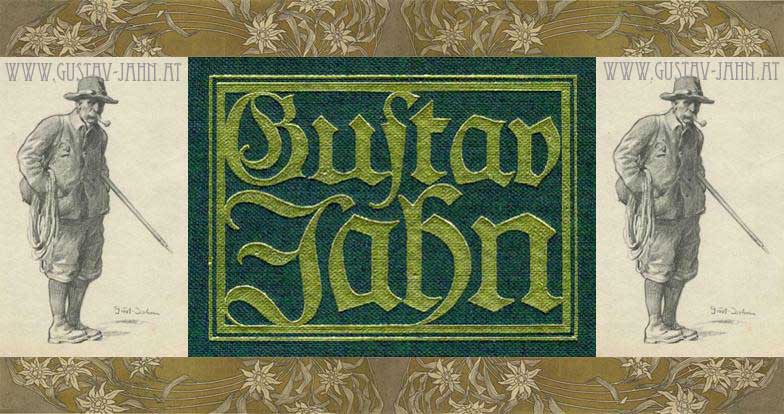
|








 World Fair Saint Louis 1904 Official Catalogue of Art_LR.jpg) OFFICIAL CATALOGUE OF EXHIBITORS
OFFICIAL CATALOGUE OF EXHIBITORS


















